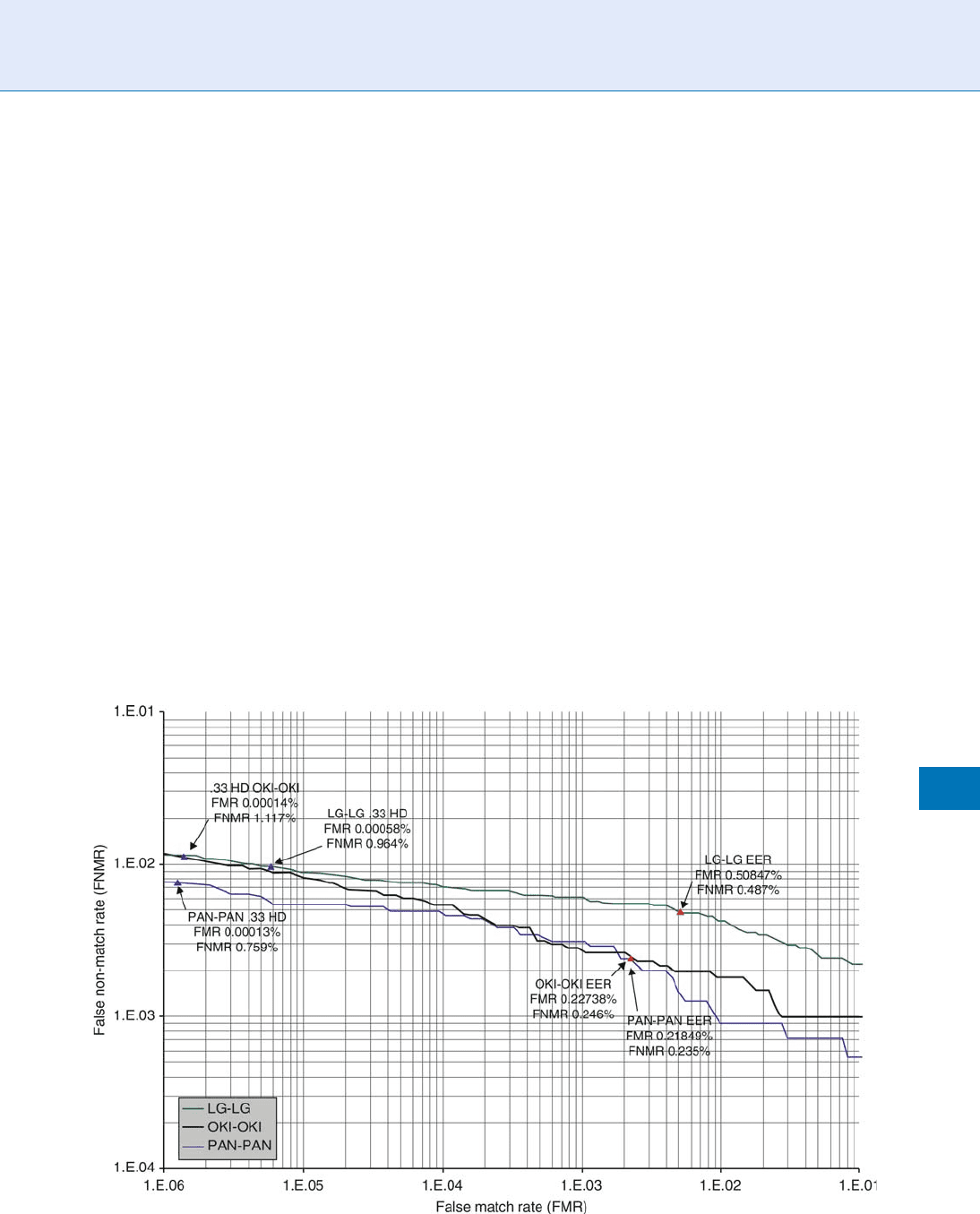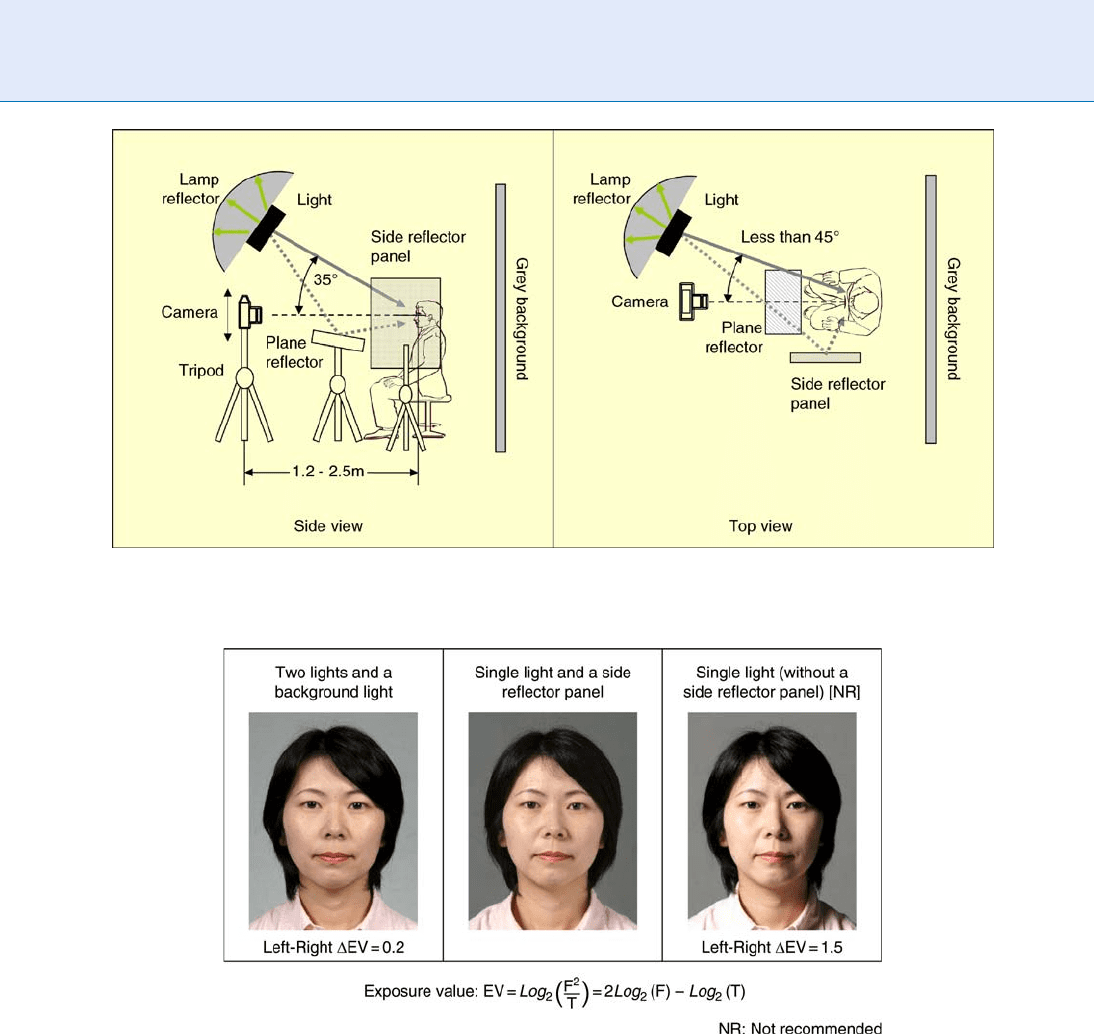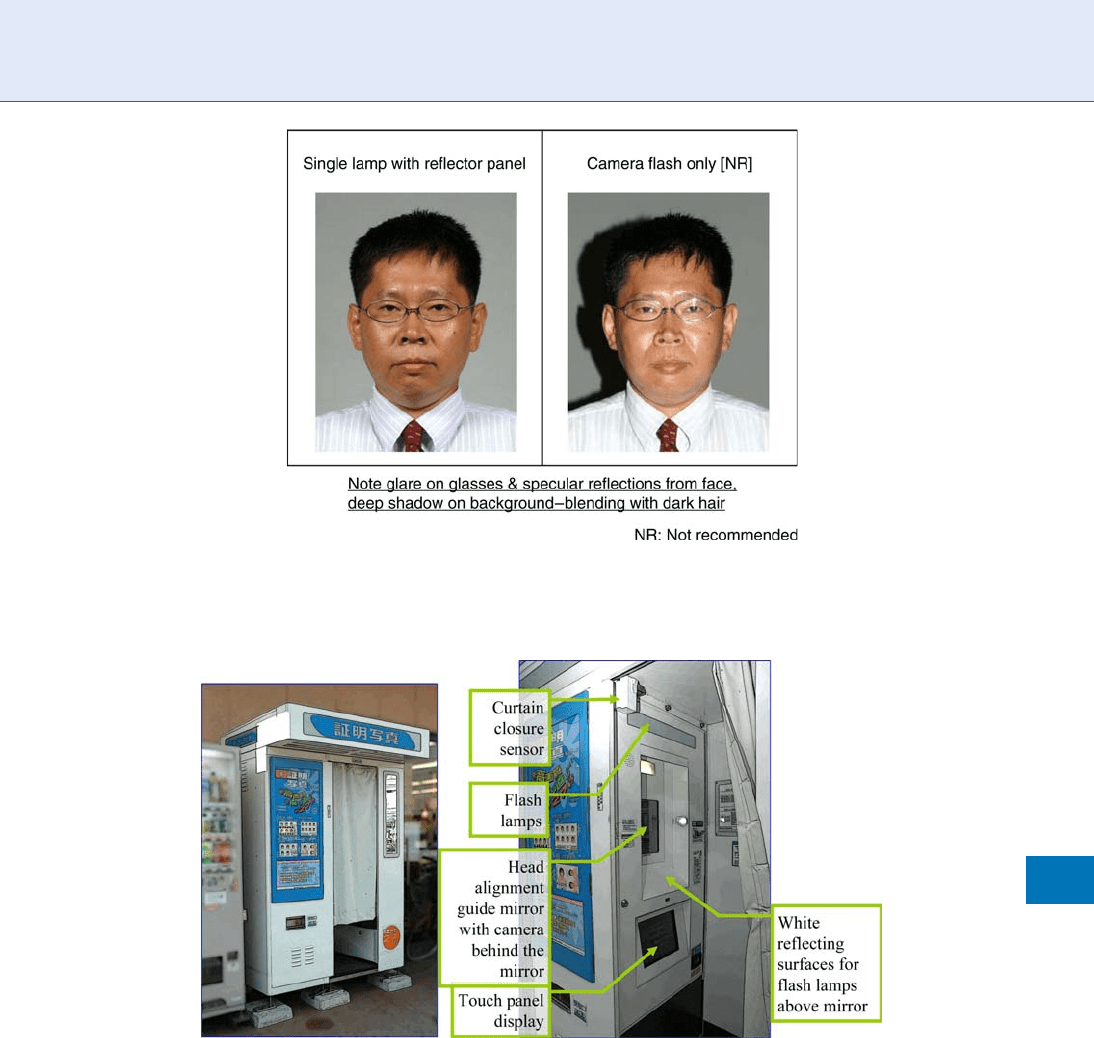Li S.Z., Jain A.K. (eds.) Encyclopedia of Biometrics
Подождите немного. Документ загружается.


calibration and monitoring requires standardized
approaches to data collection, data management, pro-
cessing, and results generation.
Types of Biometric Performance Testing
Standards
Biometric performance tests are typically categorized
as technology tests, scenario tests, or operational tests.
These test types share commonalities – addressed in
framework performance testing standards – but also
differ in important ways.
▶ Technology tests are those in which biomet-
ric algorithms enroll and compare archived (i.e.,
previously-collected) data. An essential characteristic
of technology testing is that the test subject is not ‘‘in
the loop’’ – the test subject provides data in advance,
and biometric algorithms are implemented to process
large quantities of test data. Technology tests often
involve cross-comparison of hundreds of thousands
of biometric samples over the course of days or
weeks. Methods of executing and handling the out-
puts of such cross-comparisons are a major component
of technology-based performance testing standards.
Technology tests are suitable for evaluation of both
verification- and identification-based systems, although
most technology tests are verification-based. Technolo-
gy testing standards accommodate evaluations based on
biometric data collected in an operational system as well
as evaluations based on biometric data collected for the
specific purpose of testing. Technology tests based on
operational data are often designed to validate or project
the performance of a fielded system, whereas technology
tests based on specially-collected data are typically more
exploratory or experimental.
▶ Scenario tests are those in which biometric sys-
tems collect and process data from test subjects in a
specified application. An essential characteristic of sce-
nario testing is that the test subject is ‘‘in the loop,’’
interacting with capture devices in a fashion represen-
tative of a target application. Scenario tests evaluate
end-to-end systems, inclusive of capture device, qual-
ity validation software, enrollment software, and
matching software. Scenario tests are based on smaller
sample sizes than technology tests due to the costs of
recruiting and managing interactions with test subjects
(even large scenario tests rarely exceed more than
several hundred test subjects). Scenario tests are also
limited in that there is no practical way to standardize
the time between enrollment- and recognition-phase
data collection. This duration may be days or weeks,
depending on the accessibility of test subjects.
Scenario-based performance testing standards have
defined the taxonomy for interaction between the
test subject and the sensor; this taxonomy addresses
presentations, attempts, and transactions, each of
which describes a type of interaction between a test
subject and a biometric system. This is particularly
important in that scenario testing is uniquely able
to quantify ‘‘level of effort’’ in biometric system
usage; level of effort directly impacts both accuracy
and capture rates.
▶ Operational tests are those in which a biometric
system collects and processes data from actual system
users in a field application. Operational tests differ
fundamentally from technology and scenario tests in
that the experimenter has limited control over data
collection and processing. Because operational tests
should not interfere with or alter the operational usage
being evaluated, it may be difficult to establish ground
truth at the subject or sample level. As a result, opera-
tional tests may or may not be able to evaluate false
accept rates (FAR), false reject rates (FRR), or failure
to enroll rates (FTE); instead they may only be able to
evaluate acceptance rates (without distinction between
genuine and impostor) and operational throughput.
One of the many challenges facing developers of
operational testing standards is the fact that each opera-
tional system differs in some way from all others, such
that defining commonalities across all such tests is diffi-
cult to achieve. It is therefore essential that opera-
tional performance test reports specify which elements
were measurable and which were not. Operational
tests may also evaluate performance over time, such
as with a system in operation for a number of months
or years.
In a general sense, as a given biometric technol-
ogy matures, it passes through the cycle of technology,
scenario, and then operational testing. Biometric tests
may combine aspects of technology, scenario, and op-
erational testing . For example, a test might combine
controlled, ‘‘online’’ data collection from test subjects
(an element of scenario testing) with full, ‘‘offline’’
comparison of this data (an element of technology
testing). This methodology was impleme nted in iris
recognition testing sponsored by the US Department
of Homeland Securit y in 2005 [1 ].
1070
P
Performance Testing Methodology Standardization

Elements Required in Biometric
Performance Testing Standards
Biometric performance testing standards address the
following areas:
1. Test planning, including requirements pertaining
to t est objectives, timeframes, controlling test vari-
ables, data collection methods, and data processing
methods.
2. Hardware and software configuration and calibra-
tion, including requirements pertaining to algo-
rithm implementation and device settings.
3. Data collection and management, including require-
ments per taining to identification of random and
systematic errors, collection of personally-identifi-
able-data, and establishing ground truth.
4. Enrollment and comparison processes, including
requirements pertaining to implementation of gen-
uine and impostor attempts and transactions for
identification and verification.
5. Calculation of performance results, including for-
mulae for calculating match rates, capture rates
(FTA and FTE), and throughput rates.
6. Determination of statistical significance, including
requirements pertaining to confidence interval cal-
culation and repor ting.
7. Methodology and results reporting, including require-
ments pertaining to test report contents and format.
One of the major accomplishments of biometric test-
ing standards has been to specify the manner in which
the tradeoff between FMR and FNMR is rendered in
chart form.
Verification system performance can be rendered
through detection error trade-off (DET) curves or
receiver operating characteristic (ROC) curves. DET
curve plots false positive and false negative error rates
on both axes (false positives on the x-axis and false
negatives on the y-axis), as shown below. ROC curves
plot of the rate of false positives (i.e., impostor attempts
accepted) on the x-axis against the corresponding rate
of true positives (i.e., genuine attempts accepted) on
the y-axis plotted parametrically as a function of the
decision threshold (Fig. 1).
Identification system performance rendering is
slightly more complex, and is dependent on whether
the test is open-set or closed-set.
Performance Testing Methodology Standardization. Figure 1 Detection error tradeoff (DET) curve.
Performance Testing Methodology Standardization
P
1071
P

Depending on the type of test (technology, scenario,
operational), certain elements will be emphasized more
than others, and results of the presentation will differ
based on whether a test implements verification or
identification.
Published Standards and Ongoing
Efforts – International and National
Activities
Several biometric performance testing standards hav e
been published, and many additional biometric per-
formance testing standards are in development. This sec-
tion discusses ISO/IEC 19795-1, -2, and -3. ISO/IEC
19795-4 is discussed below under Performance testing
and interoperability. These four standards are listed
in the Registry of USG Recommended Biometric
Standards Version 1.0, DRAFT for Public Comment,
NSTC Subcommittee on Biometrics and Identity
Management.
ISO/IEC 19795-1:2006 Information technology –
Biometric per formance testing and reporting – Part 1:
Principles and framework [2] can be considered the
starting point for biometric performance testing stan-
dardization. This document specifies how to calculate
metrics such as false match rates (FMR), false non-
match rates (FNMR), false accept rates (FAR), false
reject rates (FRR), failu re to enroll rates (FTE), failure
to acquire rates (FTA), false positive identification
rates (FPIR), and false negative identification rates
(FNIR). 19795-1 treats both verification and identifi-
cation testing, and is agnostic as to modality (e.g.,
fingerprint, face recognition) and test type (technolo-
gy, scenario, operational).
ISO/IEC 19795-2:2007 Information technology –
Biometric performance testing and reporting – Part 2:
Testing methodologies for technology and scenario evalua-
tion [3] specifies requirements for technology and sce-
nario evaluations, describe d above. The large majority
of biometric tests are of one of these two generic evalu-
ation types. 19795-2 builds on 19795-1, and is
concerned with ‘‘development and full description
of protocols for technology and scenario evaluations’’
as well as ‘‘execution and reporting of biometric evalua-
tions reflective of the parameters associated with bio-
metric evaluation types.’’ [4] 19795-2 specifies which
performance metrics and associated data must be
reported for each type of test. The standard also
specifies requirements for reporting on decision
policies whereby enrollment and matching errors are
declared.
ISO/IEC TR 19795-3:2007 Information technology –
Biometric per formance testing and reporting – Part 3:
Modality-specific testing [5] is a technical report
on modality-specific considerations. 19795-1 and -2
are modality-agnostic (although they are heavily
informed by experts’ experience with fingerprint, face,
and iris recognition systems). 19795-3, by contrast,
reports on considerations specific to performance
testing of fingerprint, face, iris, hand geometry, voice,
vein recognition, signature verification, and other
modalities. These considerations are important to
deployers and system developers, as test processes
vary from modality to modality. For example, in iris
recognition testing, documenting biometric-oriented
interaction between the subject and sensor is a central
consideration to both usability and accuracy; in face
recognition testing, capture variables are much less
likely to impact performance.
Within the US, three biometric performance test-
ing standards were developed prior to publication of
the ISO IEC standards discussed above.
1. ANSI INCITS 409.1-2005 Information Technology –
Biometric Performance Testing and Reporting –
Part 1: Principles and Framework
2. ANSI INCITS 409.2-2005 Information Technology –
Biometric Performance Testing and Reporting –
Part 2: Technology Testing and Reporting
3. ANSI INCITS 409.3-2005 Information Technology –
Biometric Performance Testing and Reporting –
Part 3: Scenario Testing and Reporting
Performance Testing and
Interoperability
ISO/IEC 19795-4 Bio metric performance testing and
reporting – Part 4: Interoperabilit y performance testing
specifies requirements for evaluating the accuracy and
interoperability of biometric data captured or pro-
cessed through different vendors’ systems. The stan-
dard, whose publication is anticipated in 2008, can be
used to evaluate systems that collect data in accordance
with 19794-N data exchange standards. 19795-4 helps
1072
P
Performance Testing Methodology Standardization

quantify the accuracy of standards’ generic data repre-
sentations relative to those of proprietary solutions.
For example, is System A less accurate when processing
standardized data than when processing proprietary
data? Can System A reliably process standardized data
from System B, and vice versa? 19795-4 contemplates
online (scenario), offline (technology), and hybrid
(scenario and technology) tests.
19795-4 is perha ps the highest-visibilit y perfor-
mance testing standard due to the close relationship
it bears with 19794-N standards. Data interchange
standards (and conformance to these standards) have
been the focus of much of the international commu-
nity’s efforts in biometric standardization. 19795-4
specified methods through which the adequacy of
these standards can be implicitly or explicitly evalu-
ated, leading to revisions or improvements in the stan-
dards where necessary.
Related End-User Testing Activities
Test efforts that have asserted compliance with pub-
lished performance testing standards include but are
not limited to the following:
1. NIST Minuti ae Interoperability Exchange Test
(MINEX) [6], asserts compliance with ISO/IEC
19795-4, Interoperability performance testing.
2. U.S. Transportation Security Administration Qual-
ified Product List (QPL) Testing [7], asserts com-
pliance with ANSI INCITS 409.3, Scenario Testing
and Reporting.
3. NIST Iris Interoperability Exchange Test (IREX 08)
[8], asserts compliance with ISO/IEC 19795-4,
Interoperability performance testing.
Current and Anticipated Customer
Needs in Biometric Performance
Testing
One challenge facing biometric performance testing
standardization is that of successfully communi-
cating performance results to non-specialist customers
(e.g., managers responsible for making decisions on
system implementation). To successfully utilize even
standards-compliant test reports, the reader must learn
a range of acronyms, interpret specialized charts, and
understand the test conditions and constraints. The
‘‘so what’’? is not always evident in biometric perfor-
mance test reports. This is particularly the case when
trying to graphically render error bounds and similar
uncertainty indicators associated with performance
test results.
A difficult-to-avoid limitation of biometric
performance testing standards is that tests results
will differ based on test population, collection pro-
cesses, data quality, and target application. In other
words, a systems’ error rate is not necessarily a reflec-
tion of its robustness, even if a test conforms to a
standard.
Gaps in Standards Development
Performance has been defined somewhat narrowly in the
biometric standards arena, most likely because the first-
order consideration for biometric technologies has been
the ability to reduce matching error rates. The tradition-
al focus on matching error rates – particularly FMR – in
biometric performance testing may be considered
disproportionate in the overall economy of biometric
system performance. As accuracy, enrollment, and
throughput rates improve with the maturation of bio-
metric technologies, development of performance test-
ing standards may be required in areas such as usability,
reliability, availability, and resistance to deliberate
attacks. For example, the number of ‘‘touches’’ required
to negatively impact match rates associated with images
captured from a fingerprint sensor could be the subject
of a performance testing standard.
An additional gap in biometric performance testing
standards is in testing under non-mainstream condi-
tions, such as with devices exposed to cold or to direct
sunlight, or with untrained populations and/or opera-
tors. Many tests are predicated on controlled-condition
data collection, thoug h biometric applications for
population control or military operations are often
highly uncontrolled.
Conformance testing is a third gap in performance
testing standards. The international community is
working on methods for validating that test reports
and methodologies conform to published standards.
Certain elements can be validated in an automated
fashion, such as the presence of required performance
Performance Testing Methodology Standardization
P
1073
P

data; other elements, such as those that describe how
testing was conducted, may be reliant on test lab
assertions.
Role of Industry/Academia in the
Development of the Required Testing
Methods
Biometric performance tests predated the development
of standardized methodologies by several years. Gov-
ernment and academic researchers and scientists grad-
ually refined performa nce testing methods in the early
1990s, with many seminal works performed in voice
recognition and fingerprint. The National Biometric
Test Center at San Jose State University [9] was an early
focal po int of test methodology development. Today,
leading developers of performance testing standards
include the National Institute of Standards and Tech-
nology (NIST) [10], an element of the US Department
of Commerce, and the UK National Physical Labora-
tory (NPL) [11].
Biometric vendors bring to bear considerable
expertise on performance testing, having unparalleled
experience in testing their sensors and algorithms. How-
ever, vendors are not highly motivated to pub-
lish comprehensive, standards-compliant performance
tests. Speaking generally, vendors are most interested
in practical answer to questions such as, how many
test subjects and trials are necessary to assert a FMR of
0.1%? Biometric services companies (e.g., consultancies
and systems integrators) also support government
agencies in standardized performance test design and
execution.
Summary
Biometric performance testing standards enable
repeatable evaluations of biometric algorithms and
systems in controlled lab and real-world operational
environments. Performance testing standards are cen-
tral to successful implementation of biometric systems,
as government and commercial entities must be capa-
ble of precisely measuring the accuracy and usability
of implemented systems. Deployers must also be
able to predict future performance as identification
systems grow larger and as transaction volume
increases.
References
1. http://www.biometricgroup.com/reports/public/ITIRT.html
2. http://www.iso.org/iso/iso_catalogue/catalogue_tc/ cata logue _
detail.htm?csnumber= 41447
3. http://www.iso.org/iso/iso_catalogue/catalogue_tc/ cata logue _
detail.htm?csnumber= 41448
4. http://www.iso.org/iso/iso_catalogue/catalogue_tc/ cata logue _
detail.htm?csnumber= 41448
5. http://www.iso.org/iso/iso_catalogue/catalogue_tc/ cata logue _
detail.htm?csnumber= 41449
6. http://fingerprint.nist.gov/minex/
7. http://www.tsa.gov/join/business/biometric_qualification.shtm
8. http://iris.nist.gov/irex/IREX08_conops_API_v2.pdf
9. http://www.engr.sjsu.edu/biometrics/
10. http://www.itl.nist.gov/div893/biometrics/standards.html
11. http://www.npl.co.uk
Perpetrator Identification
▶ Gait, Forensic Evidence of
Personal Data
Personal data is any information that may be used,
either individually or when combined with other
data, to identify a person. For example, a name and
address are usually sufficient to identify a person, and
so this data pair would be considered personal data. A
more subtle example is hobbies and Postal Code
obtained from a retail liquor store’s customer database.
By themselves, these data items would not be uniquely
identifying, but when linked with another database,
say, that of an iguana owners club, and add to that
the common sense knowledge that iguana make rare
pets, it becomes almost certain who patronized the
liquor store. In other words, any data that could po-
tentially reveal the identity of a person must be treated
as personal data.
▶ Privacy Issues
1074
P
Perpetrator Identification

Personal Information Search
▶ Background Checks
Person-Independent Model
▶ Universal Background Models
Phase
Every complex number a+bi can be expressed in polar
coordinate form as Ae
ip
, where A is the amplitude and
p is the phase of the complex number. The phase p can
be computed by arctan (b/a). Phase is always in the
range between zero and 2p.
▶ Iris Recognition, Overview
Phoneme
The phoneme is to spoken language what the letter is
to written language – the representation of an individ-
ual speech sound. The English word ‘‘sick’’ comprises
the three phonemes /s-I-k/, whereas ‘‘thick’’ consists
of /y-I-k/, ‘‘sack’’ consists of /s-æ-k/, and sit consists
of /s-I-t/. The phonetic symbols, which can be used
for the sounds of any language, are defined in the
International Phonetic Alphabet. Strictly speaking,
the phoneme is an abstract concept used in linguistics,
and phonemes often correspond to complex com-
pound sounds. For example, the phoneme /b/ (as in
‘‘big’’) is produced by the speaker first closing the lips
and then releasing the built-up air pressure creating a
plosive sound. The period of lip closure, the plosion
and the transitions to and from the previous and
subsequent phonemes are all identifiable as distinct
events in the audio stream.
▶ Liveness Assurance in Voice Authentication
▶ Voice Sample Synthesis
Photogrammetry
Photogrammetry is an examination of two images taken
from different positions to identify three-dimensional
points on an object or face represented in two dimen-
sions. It is akin to methods of stereoscopy.
▶ Face, Forensic Evidence of
Photography for Face Image Data
TED TOMONAGA
Konica Minolta Technology Center, Inc., Tokyo, Japan
Synonyms
Face photograph; Facial photograph; ID photograph;
Photography guidelines; Photometric guidelines
Definition
Face photography is used in passports, visas, driver
licenses, or other identification documents. Face photo-
graphs can be used by human viewers or by automated
face recognition systems, either for confirmation of a
claimed identity (usually termed verification) or, by
searching a database of face images, for determining
the possible identity of an individual (usually termed
identification). ISO/IEC 19794-5 defines a standard
data format for digital face images to allow interopera-
bility among face recognition systems, government
agencies, and other creators and users of face images.
In addition to image quality factors such as
▶ resolu-
tion,
▶ contrast, and ▶ brightness, many other factors
affect face recognition accuracy, including subject po-
sitioning,
▶ pose and ▶ expression, ▶ illumination
Photography for Face Image Data
P
1075
P

uniformity, and the use of eyeglasses or makeup, as
well as the time difference between two photographs
being compared.
Introduction
Following t he selection of a digital face image as the
primary biometric technology for use in
▶ ePassports
by the International Civil Aviation Organization
(ICAO) in 2003, machine-assisted face recognition
has become widely used for various identification and
verification purposes. Compared with other
▶ biomet-
ric technologies, face recognition is usually considered
non-invasive and more socially acceptable [1]. The
accuracy and speed of face recognition technology
has improved considerably recently, due, in part, to a
series of government-sponsored, objective competi-
tions among companies and academic institutions
producing face recognition systems [2, 3].
The face imag e interchange standard known as ISO/
IEC (International Organization for Standardization/
International Electrotechnical Commission) 19794-5
Biometric Data Interchange Formats – Face Image
Data was approved as an international standard by
ISO/IEC JTC1 SC37 in 2005 [4]. That standard defines
adataformatfordigitalfaceimagestoallowinterop-
erability among face-image-processing systems.
However, there are many factors that affect face rec-
ognition system performance, including an indivi-
dual’s appearance, such as his or her facial
characteristics, hair style, and accessories, and the
image acquisition conditions, su ch as the camera’s
field-of-view, focus and shutter speed, depth-of-
field, background, and lighting. As a consequence,
many of the countries producing ePassports have
their own guidelines for the production and submis-
sion of face photographs [5–8].
This chapter describes how to arrange lighting
and reflective surfaces relative to the camera and
subject, and provides specific adv ice on the acceptable
amount of variation in
▶ illumination across the face,
on how to avoid shadows on the face and background,
and on the design of a user interface that can help
ensure proper head positioning . Further info rmation
may be found in ISO/IEC 19794-5 Amendment
1:2007, Conditions for taking photographs for face
image data.[9]. The amendment provides explicit guid-
ance for the design of photographic studios, photo
booths, and other sites producing conventional printed
photographs or digital images of faces that may be used
in passports, visas, driver licenses, or other identifica-
tion documents.
Enrollment Guidelines
The use of automated face recognition requires that an
input face image first be enrolled by the system, that is,
the specific set of face features to be used by the
recognition system must be measured and stored. Cor-
rect enrollment requires that the input image be of
high quality and meet the following criteria. Note
that the numbers displayed in parentheses in the fol-
lowing sections are the relevant subclause numbers of
the ISO/IEC 19794-5 face image interchange standard.
Subject Guidelines
For purposes of enrollment in an automated face rec-
ognition system, the following general subject guide-
lines should be observed:
Pose angle – The subject must be in a frontal pose.
Subjects should have their shoulders square towards
the camera and be looking directly at the camera.
There should be no rotation of the head left or right
or up or down, nor should it be tilted towards either
shoulder. For rotation of the head left/right and up/
down (yaw and pitch) – the compliance requirement is
< 5
(7.2.2). For head tilt (roll) – the compliance
requirement is < 8
(7.2.2). The requirement for roll
is less restrictive, because an in-plane rotation of the
head can be corrected by automated face recognition
systems more easily.
Face size/position adjustment – The adjustment of
face size can be made, if needed, by changing the
distance between the subject and the camera or by
optical zoom magnification.
Neutral expression – The subject’s face should be
relaxed and w ithout expression; in particular, the sub-
ject should not be smiling. That is, his/her expression
should be neutral with eyes open and mouth closed.
Eyes closed/obstructed – There should be no ob-
struction of the eyes due to eyeglass rims, tint, or
glare, bangs, eye patches, head clothing, or closed
eyes (7.2.3, 7.2.11) Hats, scarves, or any other apparel
that may obstruct the face should be removed.
1076
P
Photography for Face Image Data

Background – The background should be unpat-
ternedandplain,suchasasolid-colorwallorcloth.
The background color may be a light gray , light blue,
whiteoroff-white.Thebackgroundshouldbeseparately
illuminated such that there are no shadows visible on the
background behind the subject’s face (A.2.4.3).
Camera Guidelines
To ensure correct camera focus, color, and exposure,
and minimal motion blur and geometric distortion,
the following general guidelines should be observed:
Shutter speed – The shutter speed should be hig h
enough to prevent motion blur (1/60–1/250 s), unless
electronic flash is the predominant source of
illumination.
Color balance – The image color balance should
reflect nat ural colors with respect to expected skin
tones. This value can be affected by inappropriate
white balancing or red-eye (7.3.4).
Brightness exposure/contrast – Exposure should be
checked with an exposure meter. Gradations in skin
texture should be visible, with no saturation on the
face ( 7.3.2).
Camera-to-subject distance – To ensure minimal
geometric distortion, the camera-to-subject distance
should be within the range of 1.2–2.5 m in a typical
photo studio.
Camera–subject height – The camera should be
tripod-mounted for stability. The optimum height of
the camera is at the subject’s eye-level. Height adjust-
ment can be done either by using a height-adjusting
stool for the subject or by adjusting the tripod’s height.
Centering – Keeping the subject’s face at the center
of the frame is recommended. The horizontal center of
face shall be between 45% and 55% of the image width
(8.3.2). The vertical center of the face shall be between
30% and 50% of the image height, as measured from
the top of the image (8.3.3).
Head size relative to the image size – Head width to
image width ratio should be between 5:7 and 1:2 (8.3.4,
8.3.5, A.3.2.2).
Focal length of camera lens (35 mm format equiva-
lent) – Use a normal to medium telephoto lens (50–
130 mm) (under shooting distance of 1.2–2.5 m).
Resolution – The spatial resolution should be greater
than about 2 pixels per mm. Resolution can easily be
checked by test shooting a ruler (7.3.3). For optimum
performance of a face recognition system, the number
of pixels between the eyes shall be at least 90 (8.4.1) and
preferably 120 (A.3.1.1).
Dy namic Range in Face – There should be at least
7 bits of intensity variation (i.e., at least 128 unique
values) in the facial region after conversion to grayscale
(7.4.2).
Lighting Guidelines
Artistic portraits are often taken with intentionally
uneven illumination, while face photographs taken
for the purposes of identification by humans or
machines should display even illumination of the
face. Various technical publications have reported
that the use of lighting arrangements that evenly illu-
minate the face w ithout producing shadows around
the nose or eyes improves the accuracy of automated
face recognition systems [10, 11].
Example Configurations for a Photo Studio or Store
Ty pically, a photo studio or a photo store is a profes-
sionally operated facility, equipped with a film or
digital camera, multiple adjustable light sources, a
suitable background or backdrop cloth, and subject
positioning apparatus designed to obtain high qu ality
portraits. S ome of the design consideratio ns for a
photo studio or store are described in the following
paragraphs:
Lighting uniformity (No shadows and glare) on the
face – A simple arrangement is a single light source and
multiple reflector panels to illuminate the subject’s face
uniformly. The light, shown with a lamp reflector,
should be placed approximately 35
above the line
between the camera and the subject, and be directed
towards the subject’s face at a horizontal angle of less
than 45
from the line (Fig. 1). Ideally there would be
two diffused light sources in front of the face at 45
on
either side of the camera. The maximum difference of
four exposure values on the left and right sides of
a face, chin, and forehead should be less than 1 EV
(Fig. 2). The measurements may be made by placing an
incident light meter at tho se four positions of a sub-
ject’s face and pointing the meter towards the camera.
If the values are not within 1 EV, the lights should be
repositioned more symmetrically about the subject-to-
camera line or additional reflective surfaces may be
used to redistribute the light.
Photography for Face Image Data
P
1077
P

No on-camera flash – An on-camera flash should
notbeused.Asinglebare‘‘point’’lightsourcesuchasa
camera-mounted flash often produces ‘‘hot spots’ ’
(very bright ar eas on the face) and is not acceptable for
imaging. (Fig. 3) The use of on-camera flash also can
produce ‘‘red-eye,’’ particularly for dark-adapted
subjects.
Example Configuration for a Photo Booth
A photo booth is typically a coin-operated, self-portrait
photography unit, mostly used for taking ID pictures.
Similar environments are used in registration offices for
drivers’ licenses, etc. (Figs. 4 and 5) Fig. 6 shows an
example of an arrangement of lighting and a camera for
a photo booth. Some of the system c onsiderations for a
photo booth are described in the following paragraphs:
Adjustment of head size, expression, etc. by monitor-
GUI – There are many kinds of user interface displays
for adjustment of head size and position. Figure 7
shows one of the example s of a user interface: a
head positioning frame. Even with the use of a
head-positioning display, an image preview should be
Photography for Face Image Data. Figure 2 Evenness of illumination.
Photography for Face Image Data. Figure 1 Single lamp arrangement for a photo studio.
1078
P
Photography for Face Image Data

provided to allow thesubject to recapture the image
before it’s printed or written to a storage medium,
in case the subject might deem his/her pose or expres-
sion unacceptable. Illustrations of acceptable poses
and expressions should be provided inside the booth.
Face image quality assessment software – As an
alternative to a head-positioning display,
▶ face
detection software or
▶ quality assessment software
that automatically sizes and centers the head within the
field-of-view can be used to ensur e proper head posi-
tioning. However, given that such software sometimes
does not find the face position correctly, a preview image
should be provided with provision for manual override
of the automatically determined position.
Summary
The use of proper illumination is important to obtain
face photographs suitable for identification purposes.
A key factor is the evenness of the illumination. Proper
lighting arrangements to reduce excessive shading and
Photography for Face Image Data. Figure 4 Example of a photo booth(1).
Photography for Face Image Data. Figure 3 Effect of using on-camera flash note glare glasses & specular reflections
from face, deep shadow on background –blending with dark hair.
Photography for Face Image Data
P
1079
P
